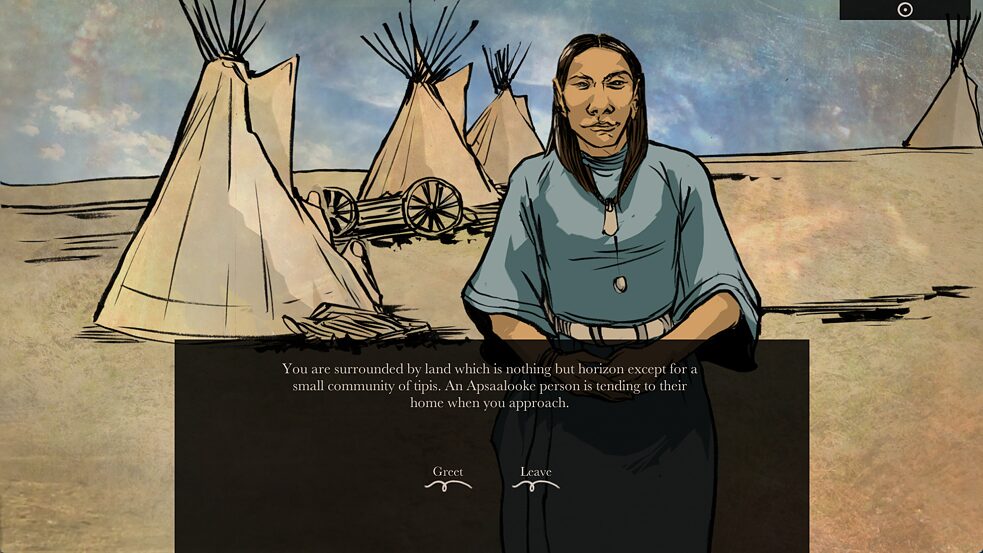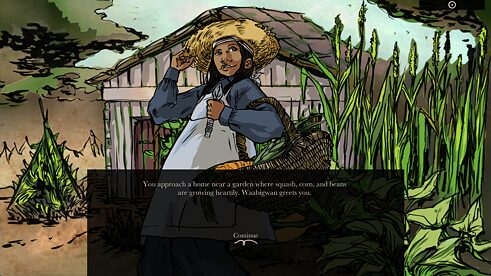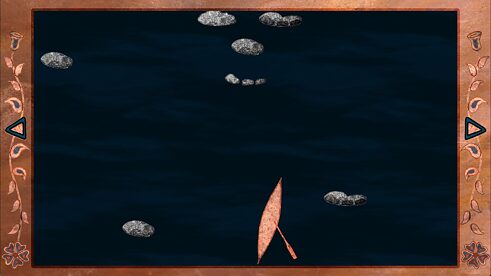Games
On the trails of the past

Understanding history through playing - Elizabeth LaPensée, assistant professor at Michigan State University and creative director for game development, is leading the way: The video game "When The Rivers Where Trails" (2019), developed in collaboration with the Indian Land Tenure Foundation and supported by the San Manuel Band of Mission Indians, condenses contributions from more than 30 Indigenous artists, writers, and musicians into an exciting and educational adventure through a period of their history marked by the displacement of Indigenous North Americans from their traditional habitats.
The complexity of Indigenous people
The main character of the game is displaced from their home in Minnesota by land grants from the American government in the 1890s and travels halfway across the country west to California. The players can first choose their clan and go on the journey as a spiritual Ajijaak (crane), mediating Name (sturgeon), warlike Makwa (bear) or protective Bizhiw (lynx) and get to know the beauty and danger of nature, hunt and fish, meet allies and opponents. Simple in design, the game achieves strong identification with the historical figures through sparse, impressive sound design and beautiful illustration work.Elisabeth Lapensée, "When Rivers Were Trails" is a collaborative production. How did this particular group of collaborators come together?
When Rivers Were Trails was initiated by Creative Co-Director Nichlas Emmons who works for the Indian Land Tenure Foundation. By talking to educators, the Foundation saw a gap in engaging middle school and high school students in history from an Indigenous perspective. We connected and I saw it as the perfect opportunity to make an Indigenous spin on The Oregon Trail, which I grew up playing in school and had long since hoped to play off of. Instead of Indigenous non-player characters being only in relation to settlers as traders, guides, or enemies, When Rivers Were Trails shows the complexity of Indigenous people thanks to contributions by thirty Indigenous writers. With beautiful art by Weshoyot Alvitre that brings to life over one hundred character scenarios, it is a game of truths, difficult decisions, and humor.
The game and its stories make the past a tangible experience. In shaping history in this way, do you think the future can be shaped as well?
Through the lens of Indigenous Futurisms, we can look to the past to inform the future but must also act in the present for the sake of the next generations. Understanding treaties isn't just about history, it's about recognizing the ongoing responsibilities of treaties today with the intention of ensuring that they are upheld. In the way that When Rivers Were Trails brings forward Indigenous perspectives of the past, games can also be a space where we imagine futures. Concerns such as climate change, the continuance of languages, and the advancement of technology in ways that are more reciprocal are just some of the many possible themes for such games.
Gameplay, story, and historical facts
It has been said that while the methods of digital storytelling are effective, they also steer the narrative farther away from “traditional” Indigenous ways of passing on teachings. What do you reply to these critics?From talking with storytellers such as Woodrow Morrison Jr. [from the board of Wisdom of the Elders, a non-profit organization that records and preserves Indigenous oral traditions and cultural arts in Oregon, Ed.] and Roger Fernandes [Native American artist, storyteller, and educator whose work focuses on the culture and arts of the Coast Salish tribes of western Washington, Ed.] , my understanding is that oral storytelling is a co-creative experience where relations are formed between story, storyteller, and listener. Games can support the same experience where the game, the designer, and the player are all responsive to one another. I see my role as a designer, artist, and writer as one of facilitation where the player(s) have a space to form their own interpretations and relate to the game experience how they want. The meaning is in the meaning you make, just like oral storytelling. Is storytelling in a game setting much different than in a more traditional way? What can traditional media learn from games?
When Rivers Were Trails aspires to be as revisitable as oral storytelling, which calls on us to return to stories throughout different phases of our lives, where suddenly new interpretations or life experiences influence how we understand the story. With multiple endings, several random happenings, and different choices to make along the way, When Rivers Were Trails can be replayed and new meanings shaped by the player.
Work together towards a better future
The game has been widely critically acclaimed. How was the feedback from the gaming community?The game has been referred to as being an entertainment title but with education, which is the highest compliment for what could otherwise just be shunted aside as an educational game. When Rivers Were Trails balances gameplay, story, and historical facts. Some live gameplay sessions have had a lot of gasps from streamers, not because of anything happening immediately in the game, since it is a point-and-click 2D game after all, but because of the terrible historical accounts that they were never aware of before. This response is intermixed with laughter during moments when jokes related to The Oregon Trail or other popular culture references show up at random. It's that back and forth weaving of harshness and humor that gives players momentum to keep playing.
In another one of your games, "We Sing For Healing", it seems as if you are intentionally slowing the player down so the experience becomes, in all its simplicity, much more immersive. "When Rivers Were Trails" does that too in a way. So is it really about immersion and teaching by creating empathic experiences?
For me, so much of my life is so overwhelmingly busy that, unless I set aside time to slow down, it just won't happen. I hope to design experiences that give people spaces to focus, to breathe, to absorb, and to reflect. Whether or not it becomes about empathy is really the player's responsibility, because the genuine work of empathy has to happen beyond playing a game. If a game I've worked on is a pathway to expanding empathy, that's amazing. But, just like storytelling is a reciprocal co-creative process, so too is gaming.
When the past is being told or retold, lessons for the future are being taught, and often the future is shaped just like the past. Is that something you hope to achieve with your game as well?
I used to make jokes about making an Indigenous take on The Oregon Trail just to get it into schools so that the problematic representations I grew up with could be undone for the next generations, and Indigenous students could see themselves in a game. It was framed as joking because I didn't think it could really happen. Thanks to the Indian Land Tenure Foundation, which received funding from the San Manuel Band of Mission Indians, and to all the people who believed in the game, it has actually happened. When Rivers Were Trails has been played in middle schools, high schools, tribal schools, tribal colleges, and universities across the United States and Canada, and even internationally including in Japan. With so many players, there are many hopes.
One hope is that youth from all over play When Rivers Were Trails and understand the past so that they can work together towards a better future. While a game can be a catalyst to think about this future, collaborative action needs to happen ongoingly to come into form.
I also hope that Indigenous youth see a game with Indigenous artists, writers, and musicians and recognize that they too can make games. Then we all get to enjoy a future with many Indigenous-led games!
What are your plans for the near future ?
Downloads from itch.io have been so successful that we are looking into more distribution pathways. The next leap for When Rivers Were Trails is to get the Mac and Windows PC versions up on Steam, which is currently underway!
"When Rivers Were Trails"
Winner of the Adaptation Award at IndieCade 2019, "When Rivers Were Trails" is about the impact of colonization on Indigenous communities in the 1890's. It is a 2D point-and-click adventure game in which "Oregon Trail" meets "Where the Water Tastes Like Wine". An Anishinaabeg in the 1890’s is displaced from their traditional territory in Minnesota and heads west to California due to the impact of allotment acts on Indigenous communities, facing Indian Agents [person that was authorized to negotiate with Indigenous peoples on behalf of the US government, Ed.], meeting people from different nations, and hunting, fishing, and canoeing along the way as they balance their wellbeing.
Download the game here.
Elizabeth LaPensée
Elizabeth LaPensée, Ph.D. is an award-winning designer, writer, artist, and researcher who creates and studies Indigenous-led media such as games and comics. She is Anishinaabe with family from Bay Mills, Métis, and Irish. She is an Assistant Professor of Media & Information and Writing, Rhetoric & American Cultures at Michigan State University and a 2018 Guggenheim Fellow. She designed and created art for Thunderbird Strike (2017), a lightning-searing side-scroller game which won Best Digital Media at imagineNATIVE Film + Media Arts Festival 2017. Most recently, she designed When Rivers Were Trails (2019), a 2D adventure game following a displaced Anishinaabe during allotment in the 1890’s, which won the Adaptation Award at IndieCade 2019.



Comments
Comment